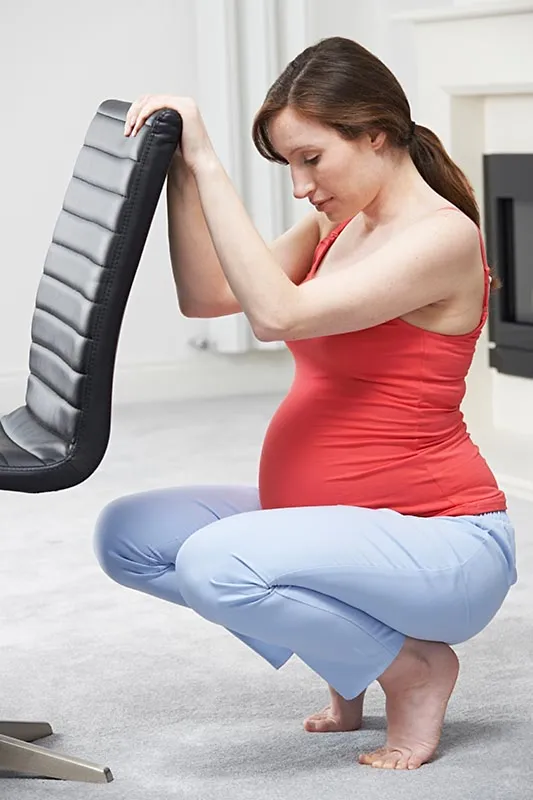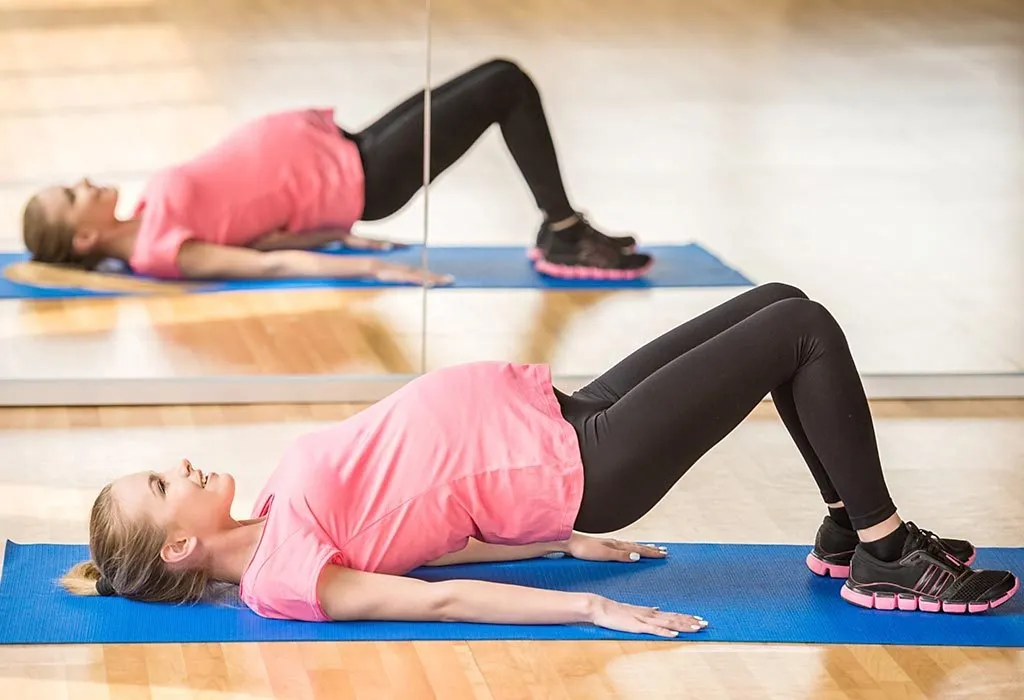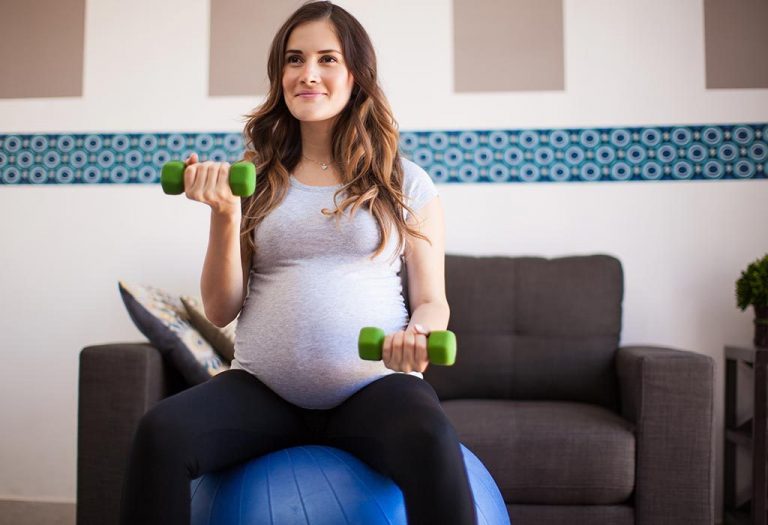Pregnancy Third Trimester Exercises

Exercising in the third trimester of pregnancy is crucial for preparing a woman for labour and promoting a smoother delivery. If exercise has not been consistent throughout pregnancy, core body muscles may be weakened from supporting the growing baby. Strengthening these muscles can provide better control during labour contractions, facilitating a more manageable childbirth process. Regular physical activity during this stage also enhances overall stamina and endurance, which are beneficial during the demanding phases of labour. Therefore, incorporating exercises tailored to pregnancy in the third trimester is highly recommended for maternal health and well-being. So, read on to learn all about exercises for pregnant women in the third trimester.
Is It Safe to Exercise During Pregnancy’s Third Trimester?
Exercising during the third trimester of pregnancy is generally safe and can be beneficial for both the mother and the baby. However, it’s essential to choose 3rd trimester exercises that are appropriate for this stage of pregnancy and to consult with a healthcare provider before starting any new exercise regimen. Activities like walking, swimming, stationary cycling, and prenatal yoga are often recommended as they are low-impact and help maintain fitness without putting undue stress on the body. It’s important to listen to your body, avoid overexertion, stay hydrated, and stop immediately if you experience any pain, dizziness, or unusual symptoms.
What Are the Benefits of Exercising During the Third Trimester?
Exercising during the third trimester of pregnancy is highly beneficial for both the mother’s well-being and preparing her body for childbirth. Here’s a detailed look at the benefits:
1. Improved Muscle Strength and Endurance
Regular exercise, such as prenatal yoga and light resistance training, helps strengthen core muscles, including the abdominal and pelvic floor muscles. Stronger muscles provide better support for the growing uterus and baby, potentially easing labor and delivery. Strengthening exercises can also help reduce back pain, a common discomfort in later pregnancy stages.
2. Enhanced Circulation and Reduced Swelling
Pregnancy often leads to increased fluid retention and swelling, especially in the lower extremities. Exercise promotes better circulation, helping to reduce swelling in the legs and feet by encouraging the movement of fluids through the body. Improved circulation also supports overall cardiovascular health, benefiting both the mother and the baby.
3. Better Posture and Balance
As the pregnancy progresses, the body’s center of gravity shifts, potentially leading to changes in posture and balance. Engaging in exercises that focus on posture, such as prenatal Pilates or specific stretches, helps maintain alignment and stability. This can reduce strain on the back and pelvis, enhancing comfort and mobility during daily activities.
4. Mood Improvement and Stress Relief
Pregnancy hormones can sometimes lead to mood swings and increased stress levels. Exercise triggers the release of endorphins, neurotransmitters known for their mood-boosting effects. This natural mood enhancement can alleviate stress and anxiety, promoting a sense of well-being and relaxation throughout the third trimester.
How Much You Should Exercise in the Third Trimester?
The American College of Obstetricians and Gynecologists advises that pregnant individuals aim for a minimum of 150 minutes of moderate-intensity physical activity each week, spread over at least three days. This should include a mix of aerobic and resistance training exercises.
However, the amount of exercise suitable during the third trimester varies depending on several factors:
- Your fitness level: If you’re new to exercise or have been inactive for a while, it’s best to start with conservative efforts and gradually increase intensity as you feel comfortable and capable.
- Your physical condition: As pregnancy progresses, fatigue can become more pronounced. It’s important to listen to your body and adjust the frequency and intensity of your workouts accordingly. This ensures you’re exercising safely and effectively to support your health and well-being throughout the third trimester.
Precautions to Take While Exercising in the Last Trimester
Here is some general advice before you start your third-trimester exercise at home:
- Refrain from exercises that need you to lie flat on your back.
- Avoid lying on your stomach.
- Keep yourself well hydrated during the exercises.
- Avoid high impact exercises that involve jumping.
- Skip exercises that require standing in one place or in one position for too long.
- Exercises that pose the risk of falling should be avoided.
- Avoid aerobic exercises if you have the following conditions – heart disease, an incompetent cervix, lung disease, multiple pregnancies, placenta previa, preeclampsia, premature contractions, and bleeding during pregnancy.
Exercises to Do During Pregnancy – Third Trimester
Below are some exercises that are safe to perform during the third trimester of pregnancy:
1. Squats

Squatting is one of the best exercises you can do to keep yourself fit, right from the start of your pregnancy up until delivery. Many doctors and midwives make women squat to use the natural force of gravity to move the baby into the lower pelvis and to help it open up. To help you with squats, grab the back of a chair with both hands to stabilize yourself and use a floor mat for some soft cushioning if you need it. Stand in a way that your feet are in line with your shoulders, and the toes point a little off to the sides and not parallel to each other. With the support of your chair, go down while bending your knees and bring your bottom as low as it is comfortable for you. Stay in this position for about 10 seconds, and while still holding the chair, slowly go back into standing position. Repeat this exercise five to seven times. Squats strengthen the muscles in the legs, lower back, and abdomen.
Avoid doing squats if you experience pain in the groin or in the pubic region. If you have placenta previa and there is a risk of rupturing, your doctor will recommend against squats.
2. Swimming and Other Pool Exercises
Do you have a pool at your local club? You need to put it to good use! The buoyancy of water lightens your body and takes the stress off your joints and weak muscles, allowing you to perform exercises which you otherwise cannot do. Before you begin, ensure that you are in water that is at least up to your chest so that it can support your weight. Try these two exercises:

- Back float: The purpose of this exercise is to take the stress off your body and help it relax and recover. When in the water, lean back and bring your legs up while stretching your arms out until you float. As you float, relax and breathe deeply for 2 to 3 minutes to help you unwind.
- Scissor leg stretch: This exercise is good for your groin muscles and the muscles of your inner thigh and lower back. Stand with your back against the wall of the pool and your arms stretched out to the sides, while you grab the edges of the wall. Raise both your legs until they form a rough “L” with your upper body. Now, spread them out in the form of a “V” as far as possible and bring them back together. Do this 10-12 times.
3. Marjaryasana (Cat-Cow Pose)

The cat-cow yoga pose is a gentle exercise that can be performed in the third trimester of pregnancy. The cat pose is effective in relieving lower back pain. It also helps in orienting your baby to the right position for birth. To perform this exercise, start on your hands and knees. Use a floor mat to perform this exercise and avoid stressing your knees. Place your hands and knees in line with your shoulders, and position your head down, facing the floor. Take a breath as you exhale, and arch your back like a cat while pulling your belly up, toward your spine. Your head and hips are pulled in while you maintain the arched position for a few seconds. As you take your next breath, bring your back and hips to the original position. Repeat the exercise five to eight times.
4. Pelvic Floor Exercises
The muscles located in the pelvic floor support organs such as the uterus and control the urinary bladder and vagina. During pregnancy, as your baby grows, the increasing stress on the pelvic floor muscles stretches them. Doing kegel exercises helps in strengthening the muscle group.
To isolate the pelvic floor muscles, try to stop the flow of urine while you are urinating. The muscles you contracted to stop the urine are the pelvic floor muscles. To exercise them, try these:

- Rapid contractions: Contract the muscles fast and forcefully; draw them inward and up and relax. Start with 10 repetitions, and go up to 50.
- Slow holds: As you advance in strengthening the muscles, increase the force with which you contract the muscles and pull them up higher while holding the contractions for five counts. Do these about 15 times.
5. Walking and Stair Climbing
Walking is the easiest of all the exercises, especially when you cannot do the other exercises. Walking will help you stay fit throughout your pregnancy. All you really need for it is a pair of comfortable shoes and a sidewalk or a park. Walking is a low-impact exercise and is one of the safest exercises during pregnancy. It can be done even when a woman is 38 weeks pregnant. Just walk at a comfortable pace.

Stair climbing is also a great exercise that is good for a woman’s lower body, as it strengthens the muscles which later make the delivery process easier. Ensure the stairs you are taking aren’t steep and have railing support so you can climb safely.
6. Yoga
Low-impact exercises are incredibly beneficial for pregnant women in their third trimester, and yoga is one such exercise. Not only do the stretches help relax and tone the various muscles in the body, but the relaxation techniques practised in yoga can help the mother-to-be remain calm. An important thing to remember is: it’s best to practice yoga with an instructor who specialises in training women during pregnancy.
Exercises to Avoid During the 3rd Trimester
During the third trimester of pregnancy, it’s essential to prioritize exercises that are safe and avoid activities that could pose risks to both the mother and the baby. Here’s a detailed look at exercises to avoid during this stage:
1. High-impact activities
Exercises like running, jumping jacks, or vigorous aerobics can stress joints and elevate the risk of accidental falls. Pregnancy hormones loosen ligaments and joints to prepare the body for childbirth, making it more susceptible to injury during high-impact movements. Instead, opt for low-impact exercises like walking, swimming, or stationary cycling, which provide cardiovascular benefits without the risk of impact-related injuries.
2. Exercises lying flat on your back
When lying flat on your back, especially beyond the first trimester, the weight of the growing uterus can compress the inferior vena cava—a major blood vessel that returns blood to the heart. This pressure could decrease blood flow to the uterus and placenta, potentially affecting the baby’s oxygen supply. Instead, choose exercises that allow you to maintain a more upright or inclined position, such as modified yoga poses, or use props to elevate your upper body during floor exercises.
3. Heavy lifting or straining
Activities that involve heavy lifting or intense straining should be avoided during the third trimester. These actions can increase intra-abdominal pressure and strain the abdominal muscles and pelvic floor, which are already under pressure from the growing uterus. Instead, focus on exercises that use lighter weights or resistance bands, emphasizing controlled movements and proper breathing techniques to avoid excessive strain.
4. Contact sports or activities with a risk of falling
Sports like basketball, soccer, or activities such as horseback riding or downhill skiing should be avoided due to the risk of impact to the abdomen or potential falls. During the third trimester, the center of gravity shifts as the baby grows, affecting balance and stability. Engaging in contact sports or high-risk activities increases the likelihood of injury to the abdomen or potential trauma from falls. Opt for safer alternatives like prenatal yoga, gentle stretching, or swimming, which provide exercise benefits without the risk of injury.
Warning Signs to Watch Out For
If, at any point during your workout session, you notice the following symptoms, stop and contact your doctor immediately. Some of the warning signs are:
- Leaking amniotic fluid
- Feeling dizzy, lightheaded, or nauseous
- Pain in the chest
- A rapid heartbeat that won’t slow down
- Shortness of breath
- Pain in your calf muscles, or sudden swelling of legs
- Vaginal bleeding
- A severe headache
- Intense abdominal pain
- Sudden contractions that won’t stop before the 36th week of pregnancy
- Baby doesn’t kick much or has stopped kicking
FAQs
1. Can I do exercises using an exercise ball in the third trimester?
Yes, using an exercise ball, or stability ball, can be safe and beneficial in the third trimester. It can be used for gentle bouncing, pelvic tilts, and supported squats, which can help improve posture, alleviate back pain, and strengthen the pelvic floor. Ensure that the ball is properly inflated and that you have a stable surface to hold onto if needed.
2. Are water aerobics classes suitable during the third trimester?
Water aerobics classes can be an excellent choice in the third trimester as the water supports your weight, reduces stress on the joints, and provides resistance for muscle strengthening. Ensure that the class is specifically designed for pregnant women and avoid high-intensity movements to keep the exercise moderate and safe.
3. Is it safe to practice deep squats in the third trimester?
Deep squats can be beneficial in the third trimester for opening the pelvis and preparing for labor, but they should be done with caution. Ensure you have proper form and support, such as holding onto a sturdy chair or using a wall for balance. Avoid squats that put excessive pressure on the knees or cause discomfort in the lower back.
This was all about last trimester exercises. Third-trimester pregnancy exercises, when performed with caution, can keep you physically fit while helping you with your delivery. So, try these exercises – and if you feel even a tad uncomfortable, stop immediately. You can even consult your doctor before starting with any of these exercises.
References/Resources:
1. FAQs: Exercise During Pregnancy; American College of Obstetricians and Gynecologists; https://www.acog.org/womens-health/faqs/exercise-during-pregnancy
2. Atal. R; Exercise in Pregnancy: Guidelines (Clinical Obstetrics and Gynecology); National Library of Medicine; https://pubmed.ncbi.nlm.nih.gov/27398880/; September 2016
3. Field. T, Diego. M, Delgado. J, Medina. L; Tai chi/yoga reduces prenatal depression, anxiety and sleep disturbances (Complementary Therapies in Clinical Practice); Science Direct; https://www.sciencedirect.com/science/article/abs/pii/S1744388112000801; February 2013
4. Wang. C, Wei. Y, Zhang. X, et. al.; A randomized clinical trial of exercise during pregnancy to prevent gestational diabetes mellitus and improve pregnancy outcome in overweight and obese pregnant women; American Journal of Obstetrics & Gynecology; https://www.ajog.org/article/S0002-9378(17)30172-2/fulltext; April 2017
5. Pregnancy and exercise; Better Health Channel; https://www.betterhealth.vic.gov.au/health/healthyliving/pregnancy-and-exercise
6. Exercise in pregnancy; NHS; https://www.nhs.uk/pregnancy/keeping-well/exercise/
7. Pregnancy exercises; Mayo Clinic; https://www.mayoclinic.org/healthy-lifestyle/pregnancy-week-by-week/in-depth/pregnancy-exercises/art-20546799
Third Trimester Diet
Third Trimester Ultrasound
Exercises You Should Avoid when Pregnant
Common Pregnancy Problems in the Third Trimester
Things to Do and Avoid during Third Trimester of Pregnancy
Was This Article Helpful?
Parenting is a huge responsibility, for you as a caregiver, but also for us as a parenting content platform. We understand that and take our responsibility of creating credible content seriously. FirstCry Parenting articles are written and published only after extensive research using factually sound references to deliver quality content that is accurate, validated by experts, and completely reliable. To understand how we go about creating content that is credible, read our editorial policy here.























